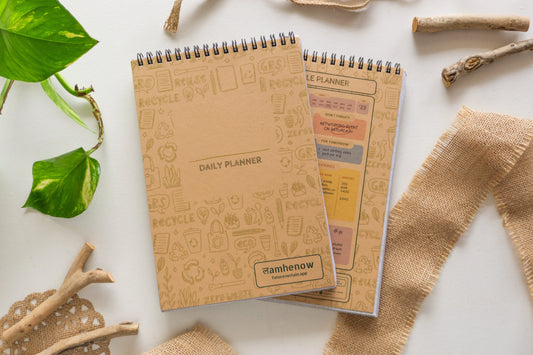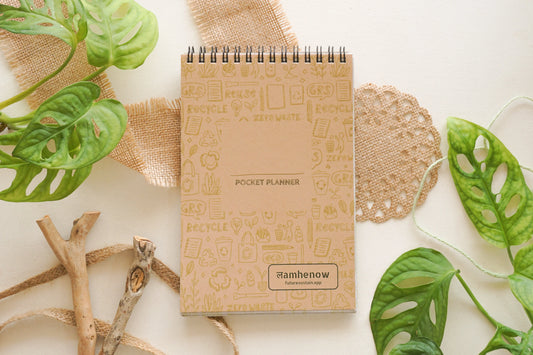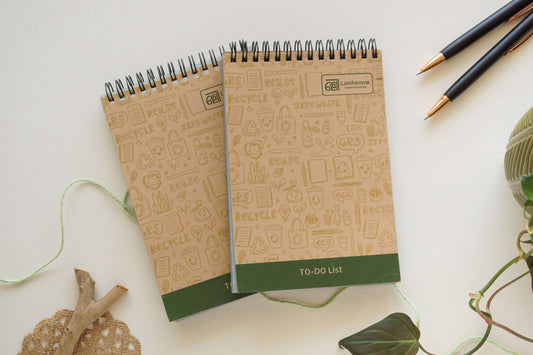![Why Eco Friendly Stationery Products Are Smarter Than Traditional Options [2025 Guide]](http://lamhenow.com/cdn/shop/articles/rn-image_picker_lib_temp_6d2d009c-b156-4a67-80d2-1eca16d8fab8.jpg?v=1750927916&width=1100)
Why Eco Friendly Stationery Products Are Smarter Than Traditional Options [2025 Guide]
Traditional stationery products make us contribute to environmental damage without us realizing it. The manufacturing process uses so big amounts of wood, water, and energy and creates waste that hurts our planet. Traditional stationery's production leaves a heavy carbon footprint by releasing greenhouse gasses during manufacturing and shipping.
The good news is that eco-friendly stationery products give us a smarter and more sustainable choice. Eco friendly stationery products in India have seen growing interest, and manufacturers are coming up with innovative solutions. India's eco-friendly stationery makers now craft items from recycled paper or materials that organizations like the Forest Stewardship Council (FSC) have certified. On top of that, these sustainable options use non-toxic ingredients instead of traditional ink formulations that contain environmentally harmful chemicals. We at Lamhenow have seen these eco-friendly alternatives match Indian consumers' and businesses' quality standards while reducing harm to the environment.
Why traditional stationery is harming the environment
Traditional stationery products create devastating environmental damage that goes way beyond what most consumers know. These everyday items and their manufacturing processes lead to resource depletion, pollution, and waste buildup.
Paper production for traditional stationery uses huge amounts of water and energy. A single ton of paper needed approximately 200 cubic meters of water. The Indian paper industry has cut water usage by 80% recently. Yet the process still demands many resources. Paper production releases greenhouse gasses throughout its lifecycle - from getting raw materials to throwing it away.
Regular stationery inks contain chemicals that seriously harm the environment. Many standard inks have volatile organic compounds (VOCs) and hazardous air pollutants (HAPs) that escape during production and use. These chemicals add to photochemical smoke, air particles, and ground-level ozone in our atmosphere. These inks end up in landfills where VOCs and heavy metals poison soil and water resources.
Plastic stationery items create another big environmental problem. To name just one example, disposable plastic pens come from petroleum—a non-renewable resource. These items are very hard to recycle because they mix different plastics like polypropylene, polystyrene, and ABS. The USA alone throws away about 1.6 billion pens each year.
"When I founded Lamhenow, I was shocked to discover how much waste traditional stationery generates". "Small plastic items such as pens invariably don't get segregated or recycled and end up in landfills, where they remain for centuries, eventually breaking down into harmful microplastics."
Indian eco friendly stationery manufacturers now see these environmental risks. Many create environmentally responsible alternatives that reduce these effects while keeping quality high. The transformation to eco friendly stationery products in India plays a vital role in cutting down the industry's environmental damage.
What makes eco-friendly stationery smarter
Eco-friendly stationery emerges as a smart alternative to conventional options, with benefits that go way beyond the reach and influence of environmental conservation. The economic advantages speak for themselves—refillable markers can be replenished 50 times without wear and tear. Users save up to 75% when compared to buying new products. Traditional single-use items drain both financial and natural resources continuously.
Sustainable stationery designs demonstrate remarkable resource efficiency. One manufacturer saved a staggering 32 tons of plastic in 2023 through refillable marker systems—equal to 2.5 million individual markers. Most refillable markers contain 93% recycled materials. The MOLOTOW SKETCHER employs 92% recycled plastic, which reduces CO₂ emissions by about 80% each year.
"At Lamhenow, we've seen tremendous interest in refillable pens among Indian businesses". "Our customers are particularly drawn to products that offer both sustainability and cost savings over time."
The smart features of eco-friendly stationery include:
- Newspaper pencils that help recreating new products instead of waste
- FSC-certified paper products that ensure responsible forest management and curb deforestation
- Vegetable-based inks with 41% water and 36% alcohol instead of harmful chemicals
- Reusable notebooks that eliminate paper waste while keeping full functionality
Indian eco-friendly stationery products are adopting these breakthroughs faster. Several manufacturers now create items using sustainable materials like recycled cotton, hemp, and FSC-certified paper.
Minimalist packaging approaches reduce environmental impact even further. Eco-friendly stationery products skip unnecessary plastic windows, glossy coatings, and multi-layer laminates. This makes packages easier to recycle.
These smart alternatives provide better value through longer product life, less waste, and lower lifetime costs. They're not just environmentally responsible—they make economic sense too.
How Indian businesses and consumers are making the switch
India's stationery industry has seen remarkable changes in business and consumer choices. Market research shows the eco-friendly products segment will grow at 12.6% CAGR from 2021 to 2028. This growth reflects people's growing awareness and changing priorities.
Indian manufacturers lead this transformation. My journey with Lamhenow began in 2019 with a vision to make eco-friendly stationery available to everyone. The first six months went into product testing before I traveled 20,000 kilometers by scooter to showcase our eco-friendly alternatives. Lamhenow has now saved approximately 5,625 kgs of wood, 15,000 kWH of energy, and 131,250 liters of water through eco-friendly practices.
Green-O-Tech India, a 14-year old company, produces notebooks and stationery from 100% recycled paper. Their client base includes over 500 government organizations, corporations, and educational institutions.
The government supports this shift through the Eco-mark Rules 2024. These rules aim to revamp eco-labeling regulations and encourage environmentally friendly products. The policy boosts both the need and production of green products, which encourages sustainable industries nationwide.
Corporate India embraces this change for three main reasons:
- Environmental policies: Organizations include recycled stationery in their Corporate Environmental Policies or CSR initiatives
- Digital transformation: Digital tool adoption has cut paper use by 40% in some businesses
- Cost efficiency: Eco-friendly stationery proves economical long-term despite higher upfront costs by reducing waste and saving resources
Educational institutions play a vital role in this transformation. Schools now choose eco-friendly supplies to line up classroom practices with environmental curriculum. This helps young generations understand conservation better.
Fortune Enterprises focuses on affordability while creating sustainable alternatives. They use agricultural waste and recycled materials without compromising quality or functionality. This makes eco-friendly options available to more Indians.
Conclusion
This piece shows how traditional stationery damages our environment by depleting resources, polluting with chemicals, and creating waste. Eco-friendly stationery provides a better solution that protects the environment and makes economic sense.
Lamhenow has seen Indian businesses and schools adopt green alternatives. "When we started our journey across India in 2019, few people understood the importance of eco-friendly stationery". "Today, the conversations have changed from 'why should we switch?' to 'how quickly can we implement these changes?'"
India's growing eco-friendly stationery industry proves this transformation runs deeper than a passing trend. Local companies now produce innovative items from agricultural waste, recycled materials, and sustainable sources. These products match or surpass traditional options in quality.
Eco-friendly stationery makes both environmental and financial sense. The original cost might be higher, but the benefits are worth it. Reduced waste, lower costs over time, and preserved resources make sustainable stationery the smarter choice for Indian consumers and businesses.
The year 2025 and beyond will see this change speed up. Government support through the Eco-mark Rules 2024 and better consumer awareness show that eco-friendly stationery isn't just tomorrow's solution—it's becoming today's standard in India.
FAQs
Q1. What are the main environmental impacts of traditional stationery? Traditional stationery contributes to deforestation, water pollution, and increased carbon emissions. Paper production consumes large amounts of water and energy, while conventional inks often contain harmful chemicals that can contaminate soil and water resources when disposed of improperly.
Q2. How do eco-friendly stationery products benefit the environment? Eco-friendly stationery products use recycled materials, sustainable sourcing practices, and biodegradable components. They often have minimal packaging, utilize non-toxic inks, and can be refilled or reused, significantly reducing waste and environmental impact compared to traditional options.
Q3. Are eco-friendly stationery products more expensive than traditional ones? While eco-friendly stationery may have a higher initial cost, they often prove more economical in the long run. For example, refillable markers can be replenished up to 50 times, potentially saving users up to 75% compared to buying new products repeatedly.
Q4. How are Indian businesses adapting to eco-friendly stationery? Many Indian businesses are incorporating eco-friendly stationery into their environmental policies and CSR initiatives. They're also embracing digital transformation, which has reduced paper consumption by up to 40% in some cases. The shift is driven by environmental concerns, cost efficiency, and government initiatives promoting sustainable practices.
Q5. What innovations are eco-friendly stationery manufacturers introducing? Eco-friendly stationery manufacturers are creating innovative products such as plantable stationery that grows into plants after use, pens made from recycled materials, notebooks with reusable pages, and items crafted from agricultural waste. They're also focusing on minimal packaging designs to further reduce environmental impact.





